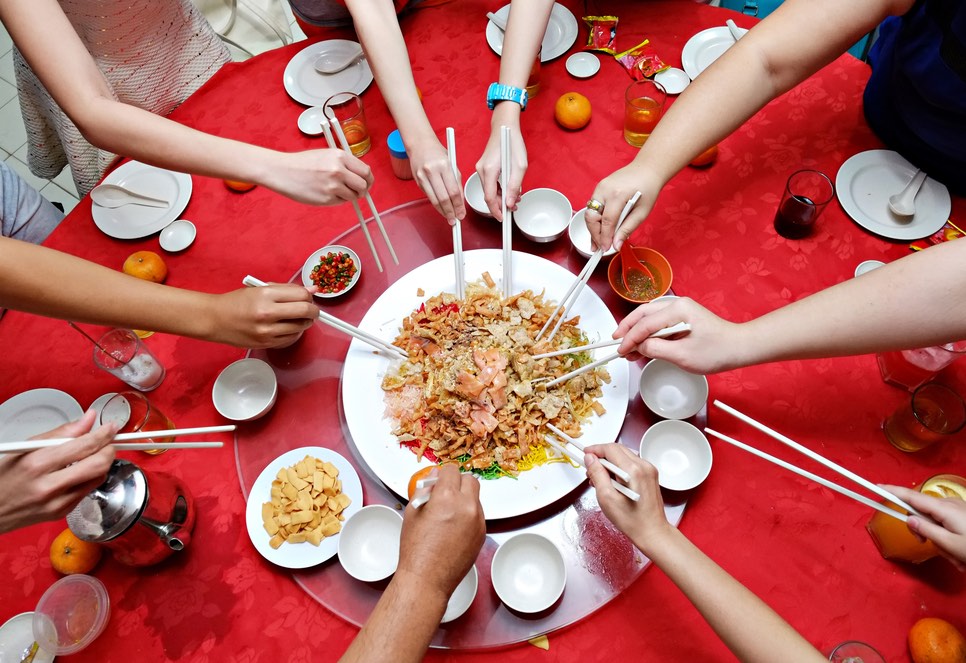From prosperity toss to ang pao giving: How Tsinoys celebrate Chinese New Year
There was hardly time to recover from the Christmas and New Year festivities when the Lunar New Year—the Spring Festival (ch’un jie) or Chinese New Year (it’s also the Vietnamese New Year or Tet)—is upon us. Sunday, Jan. 22, is the first day of the New Year.
For many Tsinoys, it’s about as major—if not more so—a holiday as the Yuletide that just transpired. While there are traditions and rituals to be followed, these vary from region to region, province to province, even family to family. The Go Puan Seng family—of the late STAR founder Betty Go Belmonte—used to hold bonfires for guests to jump over, to burn off the past year’s bad juju. Exploding firecrackers—the noisy kind, not the light-show-in-the-sky type of fireworks—scares off the bad spirits (guess the good spirits aren’t afraid of loud noises). You’re supposed to keep knives and scissors and other sharp, cutting objects away and you don’t sweep or clean the house on New Year’s Day. You do it before.
But the one constant (and the most important, I’d say) is food, and lots of it! My grandmother used to say that the New Year’s table has to have so much food that even after everyone has had his/her fill, there are still leftovers—what she called t’ng ni cai—to signify abundance that carries over into the next year.
So just as the Dec. 31 dinner had been eaten and cleared away, preparations for the Lunar New Year’s Eve dinner began. Discussions among my Tsinoy friends focused on variations of the menu and sourcing of the myriad ingredients. There are standards, tried and tested dishes that are family traditions, as well as modern additions.
One of the latter is yu sheng or yee sang, the prosperity toss, a Cantonese dish (popular too in Singapore and Malaysia) that many families here have adopted primarily because it is a lot of fun and kids love making a mess. A spread of raw fish and other seafood, pickled seaweeds, shredded vegetables (carrots, cabbage, radish, cucumber), and pickled ginger, among others is laid out in the middle of the table. Everyone gathers around and, with chopsticks, tosses the ingredients up in the air—the higher the better, it is said. After the mess is cleared away, the untossed salad is eaten with a variety of condiments.

More traditional staples are noodles, fish (which has to be whole, head to tail), dumplings (which are shaped like gold ingots), a meat dish (stories from my parents about life in rural Fujian tell that this is the time the chickens, fattened for months, are killed for this most important meal); the latter can now be a lechon or at least a whole pata, a duck or—if available—goose (turkey is not among the options this time).

Aside from all that, my table also includes what has come to be called the “family prosperity soup,” a 12-ingredient (chicken, duck, mushrooms, herbs, etc. etc.) concoction that is set to boil for at least half a day. The list of ingredients varies per family. A variation of this is called pen cai or poon chai, an earthen pot (or, literally, a basin) layered with ingredients like pork, beef, lamb, duck, abalone, sea cucumber, mushrooms, radish, and different kinds of seafood.

The meal ends on a sweet note, with nian gao or tikoy, washed down with fine tea to help with digestion after all that food (a good p’u erh from Yunnan is perfect for this).

In the past couple of years, I’ve taken to lining up a ring of kiat—those tiny oranges that are so plentiful this time of year—around my lazy susan, a nod to the recent fad of having 12—or is it 13?—round fruits supposedly for swerte or good luck. I’m not doing it this year since all the kiat I’ve bought so far are terribly sour.

I’m all for fruits of whatever shape, but this 12 round fruits craze is a very recent invention, probably of the fruit importers and vendors (brilliant marketing!), for nowhere in tradition or even folklore of China is there mention of such a belief or practice. The closest research has revealed is las doce uvas de la suerte (12 grapes of good luck) of Spain. But, as I said, fruits are good, so a dozen will certainly be 12 times as good.
My grandparents and parents were not big on rituals, so aside from a full table there’s not much my family does for the New Year. As keeper of family tradition, I insist everyone gathers around my table (symbolizing the family hearth). My amah (grandmother) used to give us kids ang pao (money in red envelopes), but since the kids in the family are now all grown up and gainfully employed, they don’t get money gifts anymore.

The malls and probably local governments will surely have festivities to celebrate the Lunar New Year now that COVID-19 restrictions are lifted. Lion/dragon dances, fireworks displays, sales of tikoy and good luck charms and trinkets, and varied rhizomes plus predictions for the year ahead on the various animal zodiac signs are all apropos for this celebration.
We’re going into the Year of the Rabbit, said to be the luckiest sign in the zodiac. Unlike the turbulent yang Tiger year, the yin Rabbit year is expected to be calmer, more passive. Whatever the year ahead holds for you, here’s wishing you good health and good cheer, peace, and prosperity.
Gong xi fa cai!


